In this section, we will present some quick but very tasty vegetarian/vegan dishes. Most of these can be
prepared and cooked in 30 minutes or less. Some of the dishes were concocted by the Wrackline Blog's author, and others by his wife.
These dishes are all meatless plant-based food, and some are purely vegan.
The author classifies himself as a "lacto/ovo/meato vegetarian". That is, I will use milk and cheese regularly, and eat yogurt every night,
and eat eggs maybe once a week. If I am presented a meat dish while visiting my kids or friends, I may eat a bit of the meat.
My wife, on the other hand, has switched to a (mostly) vegan diet.
NOTE: The "Seasoning" section and some of the individual "Cooking" sections have extra detail which may be helpful for those folks who are just learning how to cook. More experienced chefs can just skip these parts - hopefully they won't laugh too much if I have put forth some cooking gaffes!
Nutritional considerations:
Advantages of Plant Based Diet:
You have likely heard about "Plant Based" Diets. We're talking about lots of fruits and vegetables, nuts, seeds,
lentils, beans and the like. And what are the advantages of this form of eating?
In the first place, it's not a "Diet"! It's a change in the type of food one eats, without regard to quantity. Indeed,
I find that due to the absense of heavy foods, I essentially eat what I want - no calorie counts or other
limitations.
One of the big advantages of (mainly) plant-based, whole food diet lies in what you do not eat.
Every serving of vegetables, fruits, beans, lentil, nuts, or whole grains is one less serving of prepared food.
Prepared foods from American Food Industry have refined flours, too much sugar, too much salt, and
usually poor quality meat (or meat with "fillers"). These foods promote inflammation, which in turn leads to all
the "modern" diseases - chronic heart trouble, obesity, digestive problems, and cancer. Every one of these diseases
are "life-style" related. Plant-based whole foods reduce inflammation, and promote health.
What does all this mean? It means you can do the same things - in your own home - at 50, 60, 70 years
of age that you did at 30 and 40. It means you won't have to sell your home and live your last years in "assisted living"
communities.
Nutrients. Meat provides protein, to be sure, along with some iron, and some of the
B vitamins. But meat completely lacks the powerful "phytonutrients". Anthocyanin. Quertecin. Allicins.
The Carotenoids. The Flavonoids. It is these compounds that confer:
Antioxidant action. The compounds counteract the oxidizing, destructive chemicals that we absorb
from pesticides in food, poor air quality, or poor water quality. They thus help prevent cellular destruction.
Immune system boost. These compounds result in greater quantities of key immune system cells, such
as the lymphocytes, T cells, and macrophages. Also, the fiber in fruits, vegetables. and whole grains serve
as "Prebiotics", to feed the "good bacteria" in the gut and digestive tract - the "microbiome". Note that 70%
of the immune system is in the gut bacteria!
Cancer-fighting qualities. There have been numerous studies which show that the phytonutrients
can have a powerful cancer-preventing effect.
A plant based diet promotes more efficient circulation, both in the digestive tract and in the ease of blood flow. High amounts of meat tend to have a clogging effect.
Digesting meat also takes a great deal of energy. After I had a shoulder operation in 2016, my wife
and I felt like it would be well to add some meat to my diet, so that I could get more protein. (At that time
we still bought into the general belief that it takes meat to provide protein. Now we understand that you can
get all the protein you want from nuts, beans, lentils and such.) After about three days of eating meat, I came
home from work and asked my wife "Do you feel unusually tired lately?" Almost before I finished the question,
she said "Yes, I sure do!" It was then that I realized how much of an energy hit is associated with eating meat.
So, we promptly went back to our meat-free diet.
Cooking:
In general, the author prefers to cook as little as possible. Why? Because heat is pretty rough on some B vitamins,
Vitamin C, many phytonutrients, and even some minerals. Thus, when I saute something, I prefer to "carmelize"
as little as possible (even though carmelizing greatly adds to the flavor). My recommendation is that vegetables
should be still brightly colored after cooking and be somewhat crunchy. I'll still carmelize potatoes slightly in a
given dish, perhaps. During the sauteing operation, use the "fork test" to help you determine if the veggies are
soft enough.
Whole grain or whole wheat:
Many of these recipes will be pasta dishes. If you want to really amp up the nourishment, consider whole wheat or whole grain pastas.
Why? Because "durum" wheat pasta is the "white bread" of the pasta group. Durum wheat is a variety of wheat that is hard. Nonetheless
it is wheat that has been refined, and contains only the endosperm. It's just tan-colored instead of white. What does "refined" mean?
Essentially it means that all the nutrients have been removed! All the fiber, all the vitamins, and most of the minerals are processed
out and all that's left is the fine white powder that you see in the baking aisle of stores. But it's "enriched", you might say.
But actually all this means is that chemical vitamins are added back, but not the minerals or the fiberous compounds.
Here's another little-known aspect of eating refined products: white bread and other products made of white flour, "white" pasta,
and to an extent even white rice, are all converted to sugars almost as fast as eating sugar itself. They lack the complexity and
fiber of unrefined grains, and thus cause a big spike in blood sugar, which forces the pancreas to scramble and pump out some insulin
to counteract it.
Whole wheat and other whole grains, on the other hand, contain the endosperm, the germ, and the bran. This means you
get the complete nourishment of the grain as Ms Nature intended. This way the pasta becomes a significant source of
nourishment in the meal instead of just a filler.
I will admit that whole grain pasta is a bit of an "acquired taste". So you might start by using half regular pasta and half
whole wheat/whole grain.
Oils
Olive oil and coconut oil rule. Coconut oil can be used for some foods, particularly for anything requiring high heat.
Olive oil is great for everything else. "Extra virgin" olive oil is preferred. This means not necessarily that the oil has taken the vow of
celibacy, but that it is "cold-pressed", "expellier-pressed", or "mechanically pressed", AND has had no further refining. This type
of olive oil is always supplied in darker bottles, since it can be damaged by light.
On the other hand, all those pristine yellow refined oils that you see in the grocery aisles in clear bottles have been
through several processes of deodorization, bleaching, and high heat, and may have been extracted by way of solvents like hexane
or heptane (similiar to gasoline!). This level of processing produces the same result as the refining of wheat into white flour. All the vitamins,
minerals, chlorophyll, beta-carotene, and the free fatty acids are stripped from the original oil-containing seeds.
Furthermore, the high heat processes (up to 500 degrees F) cause the formation of undesireable compounds such as AGEs
(Advanced Glycation Endproducts) and even trans fats. As a matter of fact, some of the final processing steps are done
to remove the bad taste due to the accelerated breakdown caused by the initial high temperature processing steps!
Meats
If you're like me, you were raised on a meat-based diet. My typical meal was meat, potatoes, and a vegetable side. But over the
years I have come to appreciate the advantages of a plant-based diet (vegetables, whole grains, beans, rice, lentils).
As noted above, I have observed a noticably higher energy level by eliminating meats, so much so that I have to
throttle it back by starting the day with a mix of Tazo "Calm" and "Zen" teas rather than coffee. It just seems to take more energy
to digest meat. Further, over the years I have observed that high intake of meats seems to be associated with various health
issues in friends or co-workers.
In any case, you might not be ready to switch to an all plant-based diet yet. That's great. But consider perhaps a "meatless day"
or two each week to start. Consider also changing your relative portion size. Rather than have meat be the biggest portion
on your plate, let the potatoes/rices/vegetables be the larger portions. Or even consider transitioning meat to be a "condiment"
rather than a "portion". Do this by adding small amounts of beef, chicken, fish, or pork to casseroles, or by just using a smaller
portion of meat and take a small bite of it with a bite of the potatoes/rices/pastas. That way, you won't miss out on the "umami"
taste provided by the meat (I discuss umami below).
Seasoning
Most of the recipes below will simply say "the usual herbs". When you see that phrase, just look in this section. It describes the herbs/spices that the author uses for almost all of these recipes: garlic, Janes "Crazy Mixed Up Salt", and the herbs basil, parsley, oregano, thyme, and rosemary. How to get the best results from these herbs is discussed here. (Naturally, feel free to use your own favs instead!)
Garlic. You can't go wrong with garlic. It adds a rich flavor to almost any dish. Also its nutritional
benefits are very significant. You don't really need a garlic press. Just cut both ends off the clove, and at that point
the brittle outer skin can easily be lifted off (Shown in the right graphic below). If not, just lay your knife flat on top of the clove and give it a whack with the
heel of your hand. Then the outer skin can easily be removed. Then just slice the clove into small pieces. For all these dishes,
use 4-5 cloves or even more, if desired.
Always allow the garlic to "rest" for a few minutes - after being cut up - before cooking. (I usually cut up the garlic
before I do anything else). This allows the nutritional allicin compounds to combine upon exposure to air. If they don't
get this chance to combine, they will be be degraded by cooking. NOTE: This applies to onions as well!
Jane's "Crazy Mixed Up Salt". This is the author's fav all-around seasoning/salt. I sprinkle some on the veggies when I start to saute them. Feel free to use the seasoned salt or salt substitute of your choice.
"Simply Organic Spice Right All Purpose Salt Free" is a great all-around salt substitute seasoning.
Basil. Basil is great on most dishes. If you have the inclination, buy a basil plant in the spring and set it outside your back door. Then you can go outside and cut off some leaves when you need them. Nothing beats fresh basil in a dish, and this applies to all herbs. In the fall, cut off the seeds/flowers at the top of the basil plant; this will keep it producing lots of leaves. Basil is a warm weather plant and quickly goes to pot when it gets cool. Well, it doesn't really go to "Pot" as such (you wish!). Let's just say it deteriorates. During the cooler months, you can try a package of fresh basil in stores. But it usually lacks full flavor and only lasts a few days; it's best stored wrapped with a paper towel in a plastic wrapper in a cool, dry place (NOT refrigerated). You can at least buy a bottle of dried basil, or ("italian seasoning") during the cooler months.
Oregano. Oregano is great for pasta and spaghetti dishes. You can get an oregano plant in the spring as well. It's not as sensitive to cold.
Parsley. This seems to add a bit of the magic "umami" taste to dishes. You can get bunches of fresh parsley at the store, and they seem to last for quite a while in the reefer. Store in a plastic bag with a paper towel in it to absorb moisture. Change the paper towel every once in a while.
Thyme, Rosemary. These are great when added to the various vegatable/grain casseroles.
NOTE: A lot of flavor from the garlic and herbs is lost during the heat of cooking. So add a bit of
garlic when you first begin to saute the veggies or cook a soup. Then add the majority of the garlic, and all the herbs,
during the last minute or two of sauteing, or the last few minutes of cooking for soups.
NOTE: All this talk of growing your own is great for those in warm-weather states. But in northern states (like Oregon,
where the author lives), you might as well stick to bottled herbs. You can try packages of fresh herbs in stores, but as with the
basil, these may or may not last more than a few days.
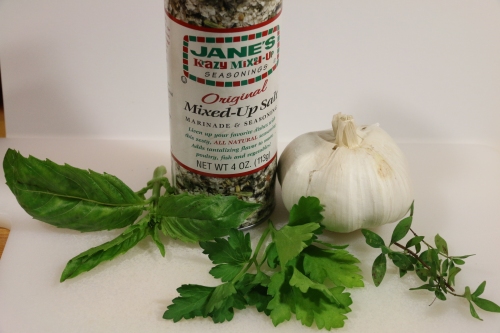 |
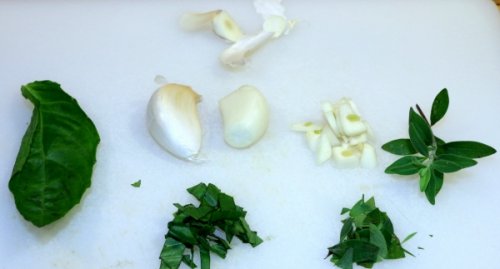 |
Jimmie's fav spices |
Preliminary herb prep shown here |
Umami
Ever wonder why certain foods or seasonings seem to produce a particularly memorable dish? Why, for example, is
soy sauce so much more flavorful on rice dishes than salt? Why does a pasta made with olives or sun-dried tomatoes
seem to be more tasty? Why does parmesian cheese add so much extra to pasta dishes or spaghetti?
The answer is "umami", the recently nominated "fifth taste", to go along with sweet, sour, bitter, and salty.
Why "recently nominated"? Because scientists discovered an "umami receptor" somwhere around 2000.
According to the Umami Information Center, umami is "a pleasant savory taste imparted by glutamate, a type of
amino acid, and ribonucleotides, including inosinate and guanylate, which occur naturally in many foods including
meat, fish, vegetables and dairy products. . . Inosinate is found primarily in meat, whereas guanylate is more abundant in
vegetables." Ref: umamiinfo.com
So now I know why I see monosodium glutamate, sodium inosinate, and sodium guanylate listed on many
processed foods as "flavor enhancers". Naturally the first thing we did when we discovered these compounds is to isolate
them and then artificially add them to food products.
|
Foods high in "umami" compounds: soy sauce worcestershire sauce sun-dried or ripe tomatoes porcini or shiitake mushrooms (dried have much more) olives parmesian cheese kombu, nori, wakame seaweeds anchovy (it's in worcestershire sauce) truffles potatoes and carrots (to a lesser extent) green tea For a more comprehensive list with more info, check out this link: |
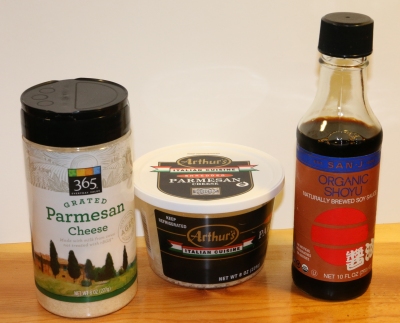 |
The image above shows some "umami enhancers" that are used in some of these dishes. The parmesian cheeses work great in the pasta or spaghetti meals. Um, yes, I can't claim they're "vegetarian/vegan"! For that, please see our "Cheese Substitutes" section right below. And finally, the soy sauce could be considered for any rice or perhaps lentil dish.
Cheese Substitutes
|
Vegan parm cheese To make a tasty, incredibly nutritious substitute for parmesian cheese, mix the following 1/4 cup nutritional yeast 3/8 cup walnuts 1/4 cup raw sunflower seeds (roasted and/or salted 1/8 cup hemp seeds By substituting this for parmesian cheese, you are gaining some B vitamins (in the yeast), |
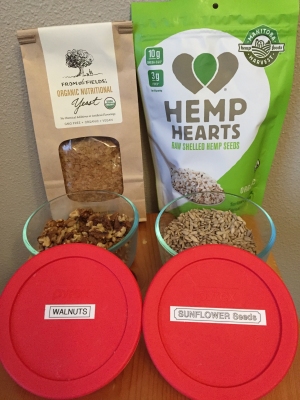 |
The Recipes
For additional taste and extra protein, lightly toast some pecans, walnuts, or slivered almonds and sprinkle on top.
If you want to amp up the "umami", add sun-dried tomatoes, olives, shiitake mushrooms, or maybe some chopped up seaweed like kombu or nori,
or substitute yellow onions for white or red onions. If you feel more adventurous, try some anchovy or truffle oil.
Note on spaghetti/pasta cooking:
Boil some water for the spaghetti/pasta. Add the spaghetti/pasta when the water is almost boiling. It can cook while you are preparing the rest.
After the water is boiling and you have added the spaghetti/pasta, you can cover the pan and turn down the heat. It's not necessary to have a furious boil to cook pastas. But watch the pan while you are doing other things. spaghetti and pasta have a tendency to boil over.
Cook spaghetti/pasta for about 10-12 minutes, stirring occasionally. Have a fork ready and, after about 8 minutes, pull out a strand or two and see if it is ready. The color will change slightly when your pasta is ready. It's better if it is not too soft. You want Al to approve. You know: "Al Dente", the universal judge of pasta dishes.
When your spaghetti/pasta is ready, dump it out in a colander to drain the water and add it back to the pan, and cover.
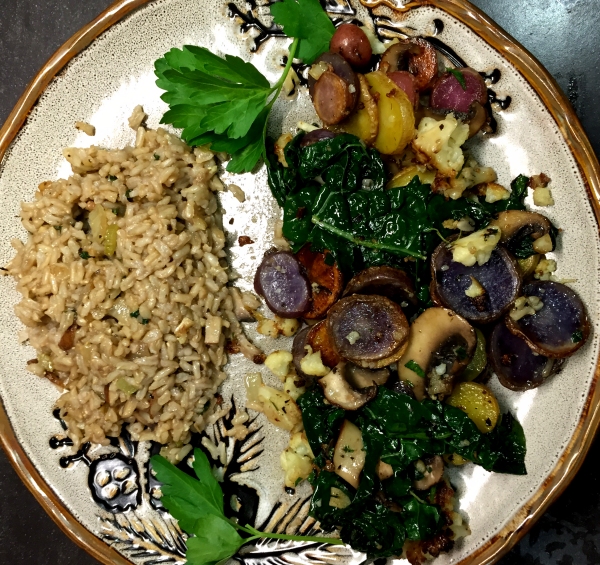 |
Mixed Potatoes, Cauliflower, Mushroom, Spinach Stir-fry with Rice PilafIngredients (for the stir-fry) multi-colored small potatoes (usually sold as an assortment in mesh packages, e.g: purple/"black"/white). Or, you can get a red, a purple, and a white potato separately. 1/2 cauliflower mushrooms (of your choice) spinach leaves (a big handful) the usual herbs (see "seasoning" above) Cooking Ingredients (for the rice) Rice (of your choice). Lunberg brown basamti rice used here. celery, a few stalks onion, about 1/2, can be yellow or "red" mushrooms (of your choice) garlic, basil Cooking |
Red and Green Pepper, leek, and Field Roast "Sausage"Ingredients 1 red and 1 green pepper 1 onion. You can use yellow, white, or "red". OR: you can use a leek. 1 or 2 Field Roast grain/vegetable-based Italian Sausage(s). They come in a package of 4. the usual herbs (see "seasoning" above) Cooking |
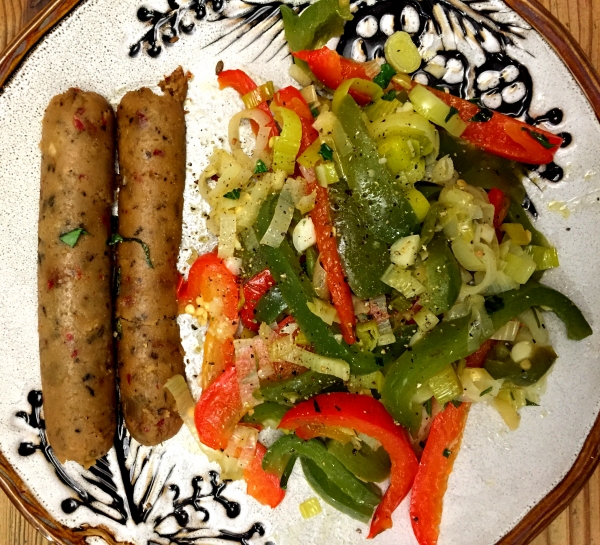 |
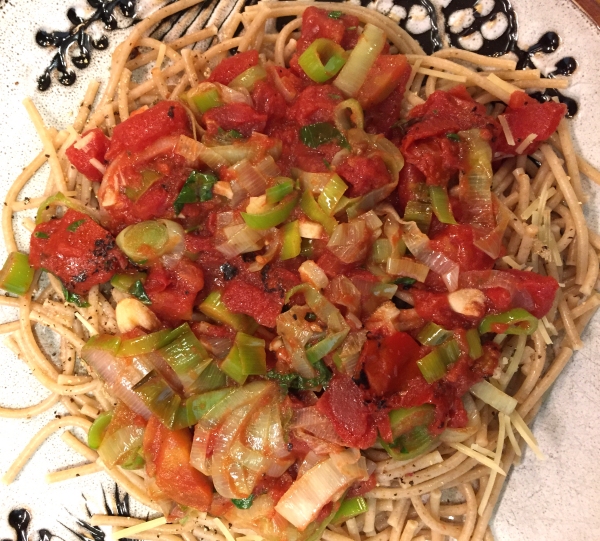 |
Leek, Stewed Tomato spaghettiIngredients 2 leeks Enough spaghetti for 2-3 servings 1 14-15oz can stewed tomatoes. The author uses Muir Glen organic fire roasted diced tomatoes or diced tomatoes with green chilies. But any type of diced or "stewed" tomatoes would work. NOTE: "Crushed" tomatoes have a lot of tomato sauce. The author thinks this dish works better without tomato sauce. (But feel free to add a small can of tomato sauce if that is your preference.) the usual herbs (see "seasoning" above) Grated parmesian cheese (usually found in the refrigerated section of stores). Optional: Dry grated parmesian cheese, such as "365" grated cheese at Whole Foods. Cooking Slice the leek into, say, 1/4 in slices. You can use some of the green section as well, in addition to the white. Note that leeks often have dirt
in their various layers. So you might rinse the leek after slicing and then drain. Preheat some olive oil in a large skillet for a minute or two,
and then add the leek and about 1/4 of the garlic. Serving: |
Yellow Onion, Shiitake Mushroom PastaIngredients 1 yellow onion (Yellow onions seem to be the most flavorful, although the "red" (purple) onions have the greatest nutrition content). About 2 cups of shiitake mushrooms (stems removed). Shiitake mushrooms are one of the umami-rich foods, but you can substitute porcini or crimini mushrooms. Enough linguini type pasta for 2-3 servings the usual herbs (see "seasoning" above) Cooking Serving: |
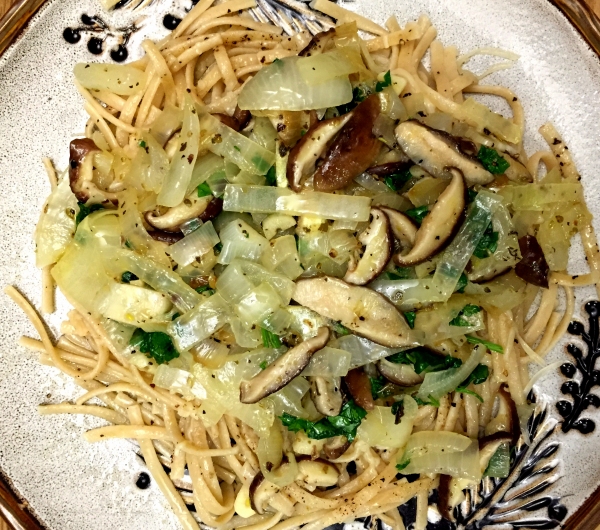 |
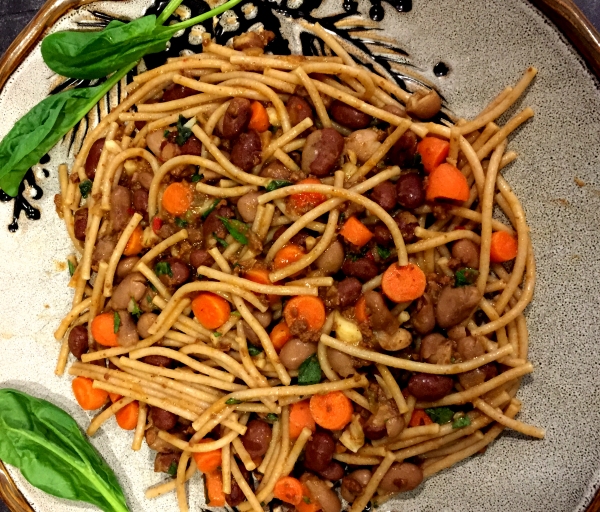 |
Jimmie's Chili spaghettiIngredients (this is a quick dish) Amy's Medium chili (Can substitute Amy's Spicy Chili, Amy's Black Bean Chili, or Amy's Medium with Vegetables Chili) (If you want a bigger amount) One can/carton of pinto, kidney, or chili beans Carrots (omit if you want a faster dish) Enough spaghetti for 2-4 servings (optional) the usual herbs (see "seasoning" above) Cooking |
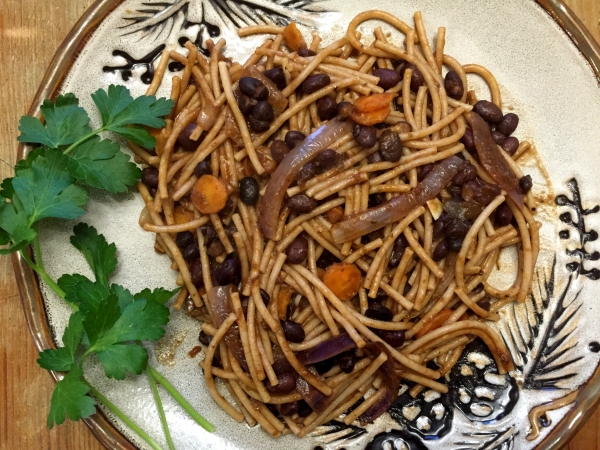 |
Jimmie's Chili spaghetti (with black beans)Here is a variation of the chili spaghetti.
This one has Amy's black bean chili and a can of black beans |
Multi-Pepper SpaghettiIngredients (this is another quick dish) Some mixed peppers. Usually these are available in a plastic package. They will usually be yellow, red, and orange. Or just use one green, one red, and one yellow pepper. Enough spaghetti (or linguini type pasta) for 2-3 servings the usual herbs (see "seasoning" above) Cooking Serving: |
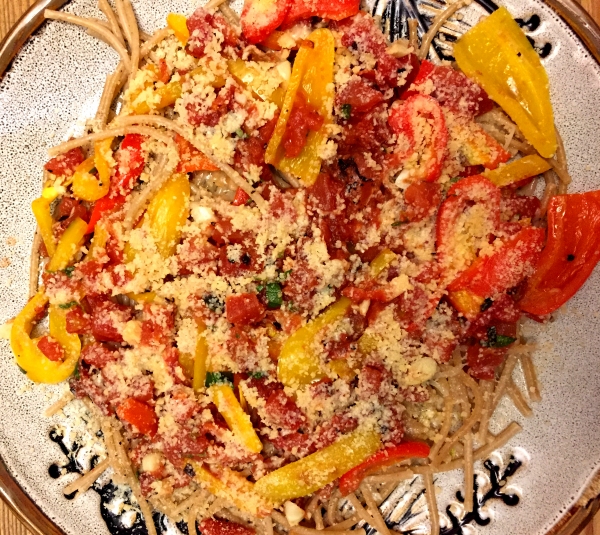 |
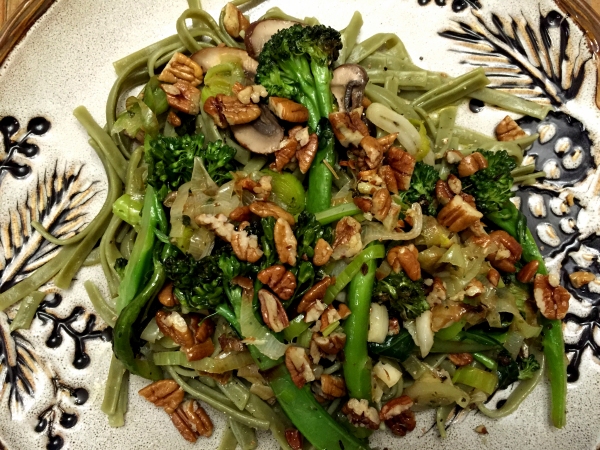 |
Broccolini-leek pastaIngredients 1 bunch broccolini (about 10-15 pieces) 1 leek 5-6 small "baby bella" mushrooms (small portabello mushrooms) Enough linguini type pasta for 2-3 servings A handful of pecans the usual herbs (see "seasoning" above). for example, in this dish, I simply used 3-4 garlic cloves and some "italian seasoning" from a bottle. Cooking Serving: |
Broccoli, onion, mushroom, red pepper pastaNOTE: The image shows a bit of the "vegan parm cheese" on top. Ingredients 8-12 broccoli florets 1/3 to 1/2 red onion (or yellow) 6-7 small crimini or "baby bella" mushrooms 1/3 to 1/2 red pepper Some spinach (optional) Enough linguini type pasta for 2-3 servings the usual herbs (see "seasoning" above) Cooking Serving: |
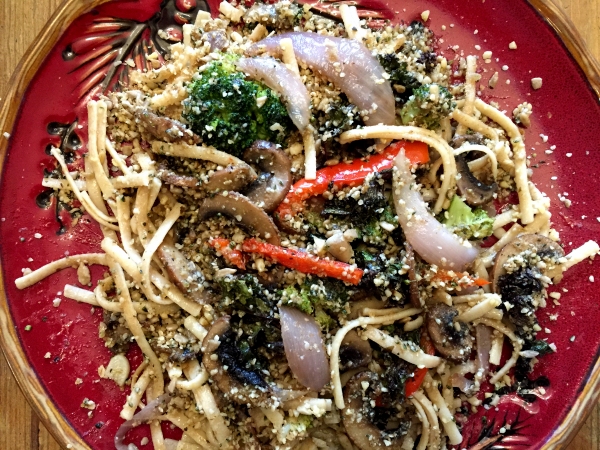 |
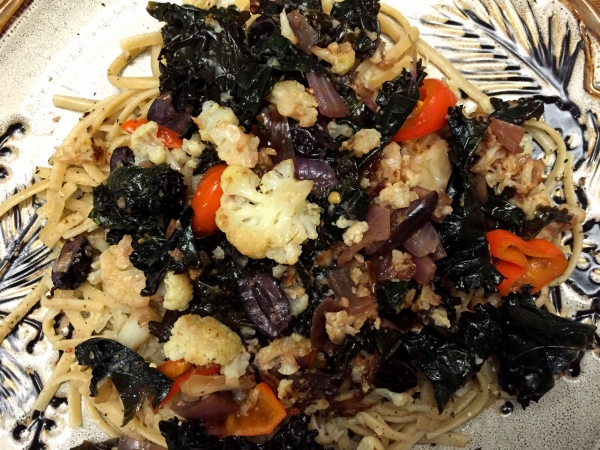 |
Cauliflower, kale, olive, onion, pepper pasta (My wife's recipe)Ingredients 1/3 to 1/2 cauliflower 2 or 3 small red peppers (from the packaged 3-pepper assortment). Or: 1/2 regular red pepper 10 - 15 black olives (bottled, Kalamata is one brand) Some kale (For this dish, any kale other than the "curly" kind) 1/3 to 1/2 red (or yellow) onion (optional) 1/2 cup white wine. Wine adds a bit of complexity to the taste of most dishes. Enough linguini type pasta for 2-3 servings the usual herbs (see "seasoning" above) Cooking |
Lentil, Vegetable, and Field Roast "Sausage" soup (my wife's recipe)Ingredients 1 cup lentils (yellow, red, or orange) about 1/2 cup frozen corn 2 ro 3 small carrots some spinach 1/2 red or yellow onion A couple of stalks of celery would be great in this soup also 1 or 2 Field Roast grain/vegetable-based Italian Sausage(s). They come in a package of 4. the usual herbs (see "seasoning" above). Or your choice. Cooking Yellow, red, or orange lentils are better for soups, and will turn mushy when cooked. Green, French green, or brown lentils remain firmer, and might be better for meals for which the lentil is served as a side dish. If you are cooking them as a side dish, the cooking time is anywhere from 15-25 minutes. Split lentils cook faster. Generally, you might try a small spoonful after about 15 minutes to see if they have reached the desired softness. Why not add salt at the beginning? Because adding salt to lentils while they are cooking tends to make them a bit tough. Thaw out the Field Roast "sausage" if frozen. Slice the sausage into about 1/4 inch thick sections. |
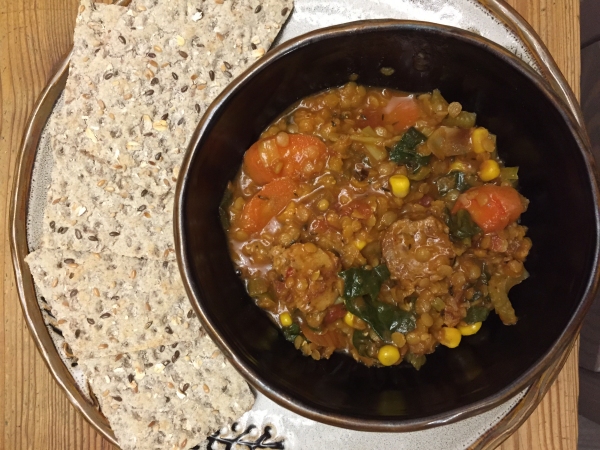 |
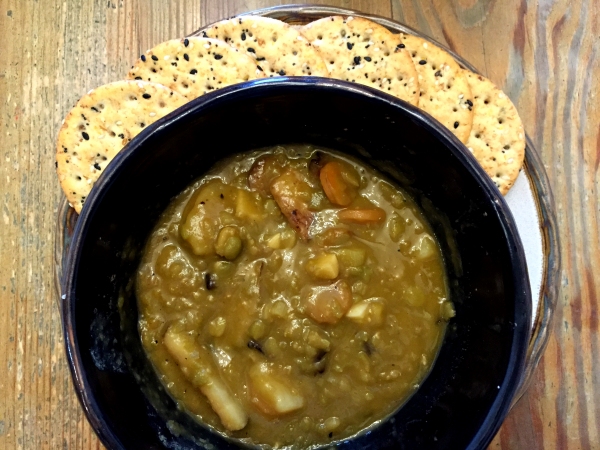 |
Split Pea-Potato-Mushroom-Carrot SoupIngredients 1 cup of dry split green peas 1/2 large russet potato, or 1 medium potato (or any potato of your choice) 3 - 4 "baby bella" mushrooms (or crimini or shiitake) 2 - 3 carrots some vegetable or chicken broth 2 - 4 cloves garlic, some Jane's Crazy salt (or your own choice). Some basil or your choice of herbs. Cooking |
Navy Bean-Mushroom-Carrot-Celery Soup
2 cans of navy beans 1 - 2 carrots 1 - 2 stalks celery Some "baby bella" mushrooms, or shiitake or crimini mushrooms some vegetable broth or mushroom broth 2 - 4 cloves garlic, some Jane's Crazy salt (or your own choice). Some basil or your choice of herbs. Cooking |
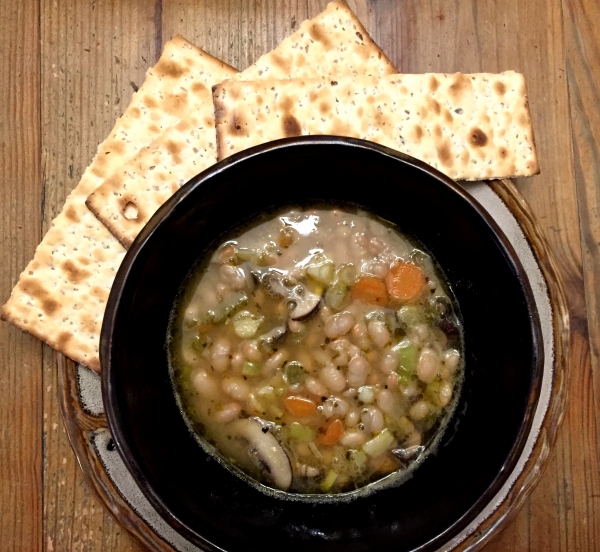 |
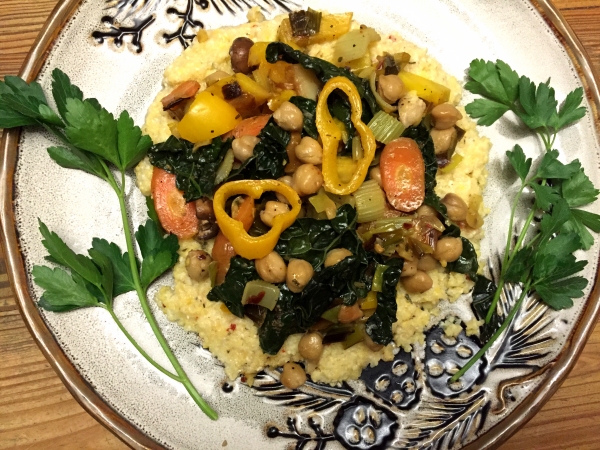 |
Garbanzo Beans and Vegetable Polenta (my wife's recipe)Ingredients 1 1/2 cups Polenta (Bob's Red Mill is great. Or just use corn meal plus coarse corn meal) 1/2 cup milk or almond milk, plus 1 1/2 cup water (for the polenta) 1 can garbanzo beans 2 gold beets 1 leek 2 carrots 1 cup (approx) crimini mushrooms (shiitake would be great as well) 1 stalk celery some kale 2 small yellow peppers (from the "assorted peppers" packages), OR 1/2 "regular" yellow pepper) 2 - 4 cloves garlic, some parsley (if you have it). Other seasonings listed below in "Cooking" Cooking Serving: |
"Ancient Grains" and Vegetables (my wife's recipe)Ingredients 1 pkg Engine 2 Ancient Grains (in freezer section of stores) 2 or 3 jalapeno peppers 2 small red peppers and 2 small orange peppers (from the "assorted peppers" packages), OR 1/2 "regular" red or orange pepper) 1/2 onion (red or yellow) some kale 1 container of pre-made salsa 2 or 3 cloves of garlic. Other seasonings listed below in "Cooking" Cooking "Simply Organic" all-seasons salt "Simply Organic" chili powder "Simply Organic" smoked paprika cumin Cook for a few minutes longer |
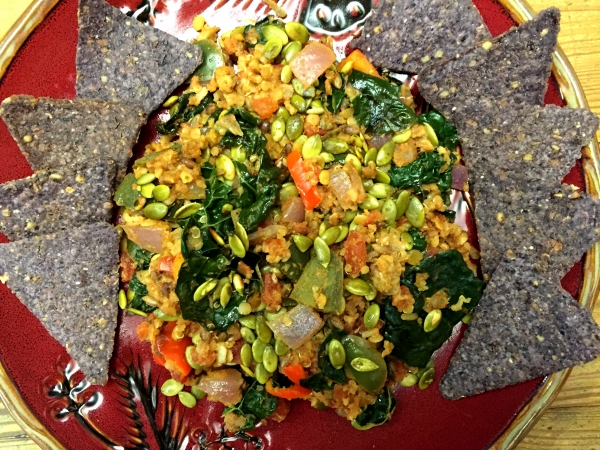 |
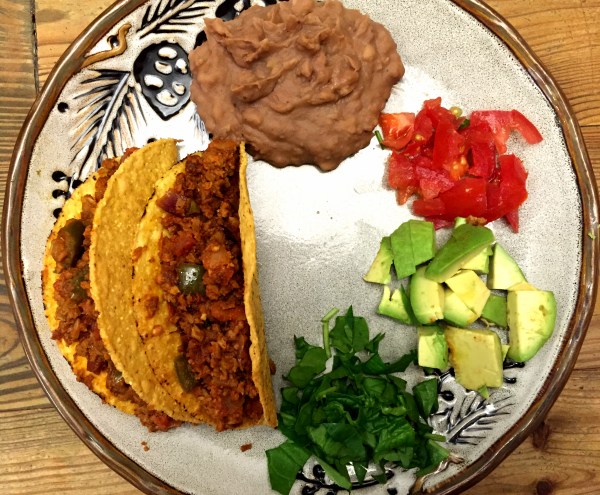 |
Veggie Tacos (my wife's recipe)Ingredients Field Roast "Classic Meatloaf" (vegetarian), 1/2 package (whole package if you want a bigger portion) One bottle mild or medium salsa. We used "Herdez" brand salsa. "Simply Organic" all-seasons salt "Simply Organic" chili powder "Simply Organic" smoked paprika cumin (NOTE: substitute the spices of your choice in lieu of these four seasonings.) 2 - 3 cloves garlic 1 red onion (can use yellow if desired) 2 - 4 jalapenos Cooking Serving |
Rice and Veggies (my wife's recipe)Ingredients 1 cup Bhutan red rice (Lotus Foods brand) - or a similiar rice some Swiss Chard 1 or 2 yellow carrots (usually come in a package of multi-colored carrots). You can use 1 or 2 regular carrots instead 1 medium orange bell pepper (or 3 orange peppers from the "assorted peppers" packages) 2 or 3 shallots a bit of "savory" seasoning (Morton and Basset) Some Spice Right all purpose seasoning Or: substitute your desired seasonings. Cooking |
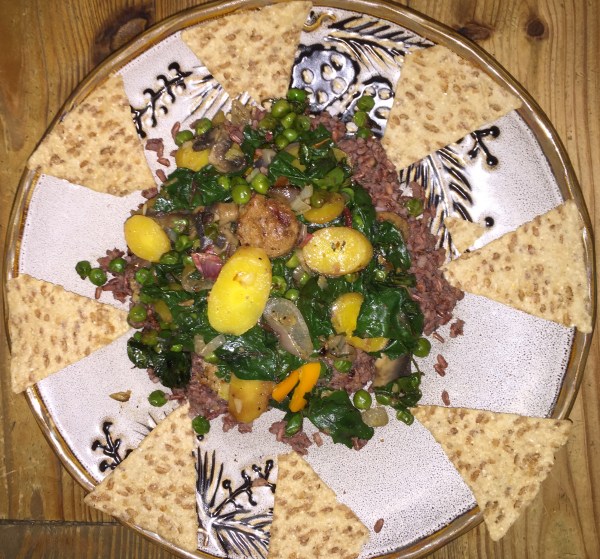 |
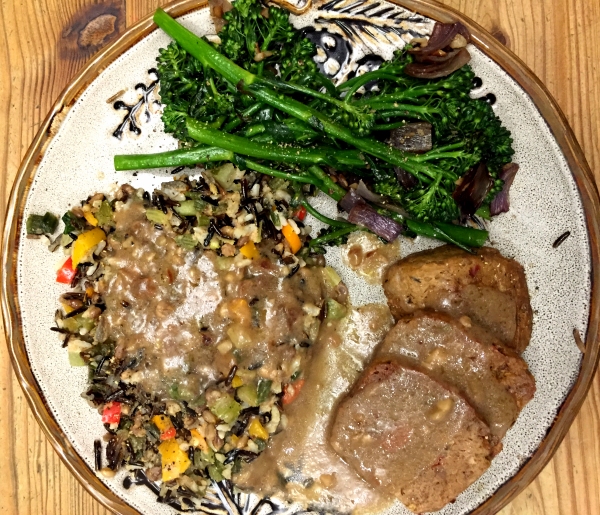 |
Field Roast "Meatloaf", Rice Pilaf, BrocolliniHere's a vegan meal that looks like the traditional "meat and potatoes" dish - meat, some sort of starch, and a side
of vegetables. The desired number of slices of Field Roast "Classic Meatloaf". Field Roast and other vegan meat substitute products are sometimes near the dairy section of stores. Ingredients (for the rice) 1 cup of your desired rice. "Lundberg Wild Blend" makes a great pilaf. 1 or 2 stalks celery, chopped 3 or 4 of the small peppers in the "assorted peppers" package, chopped 1 or 2 green onions or 1/3 - 1/2 medium onion, chopped Cooking Ingredients (for the broccolini) 1 or 2 bunches of brocollini some sliced red onion a few mushrooms (optional) Cooking Saute the onion and broccolini until soft, and add the mushrooms (if desired) and saute a few minutes more. This meal is great as is. If you want some gravy (gravy is shown in the photo), heat some olive oil in the skillet you used for the "meatloaf". When heated, gradually add some white flour, stirring constantly. Then add some vegetable/mushroom broth, if available. Otherwise add water. Add some Jane's salt or other seasoning and cook a bit longer. |
Copyright © 2024 J.A.